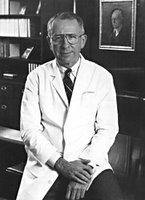 Dr. Canto
Dr. Canto is a
screening specialist for pancreatic cancer. She is from the Philippines
and graduated from the University of the Philippines. We immediately felt
a connection to her because our family lived for many years in Manila.
We arrived at JHH on the morning of the 18th and went to the 5th floor of Blalock. My mother had the EUS (Endoscopic Ultrasound) and was very nauseous after the procedure. They had
given her morphine for pain and she really didn't react well to this.
We then went to the basement for her CT scan and returned to wait to hear from
Dr. Canto. Prior to the procedure Dr. Canto had asked my mother about her symptoms. She then mentioned not to worry about the procedure and that perhaps it was not even cancer. I think my mother secretly clung to this hope as we patiently waited for Dr. Canto to arrive with the results.
We waited a long time in a small consultation room and I was worried that
this meant bad news. Dr. Canto finally arrived and confirmed that it looked like pancreatic cancer (adenocarcinoma). She mentioned the tumor was about 3.5 cm - larger than we
had originally thought. However, she added that the cancer looked resectable which is excellent news as far as these things go. We told her we had already been in contact with a Hopkins surgeon but we asked her who she would recommend. She said: "If it was my mother, I would go with Dr. Cameron". In our initial discussions with the Hopkins surgical assistants, we had heard that once you choose a surgeon you cannot switch. We mentioned this to Dr. Canto and she said it was not a problem and that it happens all the time. She said she would refer us to Dr. Cameron! That was great news and we were happy with that decision. As Dr. Canto departed, Grace
said "Salamat Po" which means "Thank You" in Filipino. Although my mother felt
really nauseous all day, I think we felt guardedly optimistic that
my mother could have the Whipple procedure.
On Monday, Dr. Canto's very kind assistant faxed over a copy of my mother's
reports and confirmed that she had referred us to Dr. Cameron. Her CA 19-9 was
801.7. We also received the CT results which stated:
Large mass in head of pancreas consistent with pancreatic cancer with
dilated pancreatic duct seen. Tumor appears to extend into the
peripancreatic soft tissues. The patient's mass abuts the SMV and the
portal vein but there is no definite evidence of invasion seen.
Encasement of gastroduodenal artery defined.
1. Mass at the head of the pancreas compatible with pancreatic cancer.
Minimal stranding of the mesenteric fat anterior to the mass, suspicious
for tumor infiltration. Tumor involvement of the posterior wall of the
gastric antrum cannot be excluded.
2. The splenic vein, portal vein, and celiac axis, and SMA are patent.
The SMV is patent, but in very close proximity to the mass and possibly
minimally compressed.
We weren't sure how to interpret the results but we thought this might put
my mother at a Stage III which was worse than we initially hoped for.
However, the results seemed to indicate she may still be resectable.
In retrospect, going through Dr. Canto for the initial screening and tests was exactly the right thing to do. She had ordered the 3D CT scan (pancreatic
protocol) and the EUS and was able to give us a referral to the surgeon we
wanted. I believe that any surgeon at the very least would have required
a 3D CT scan so going through the screening department first was time not
wasted.
I think our mother went through another small bout of depression since we had
more results showing that it was pancreatic cancer.










